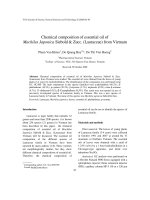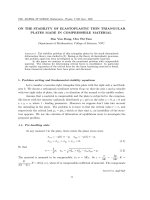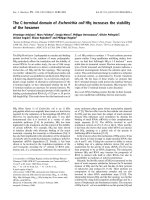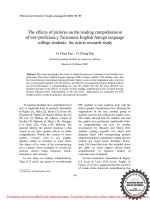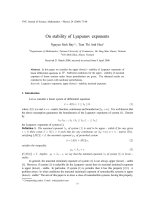Báo cáo "On stability of Lyapunov exponents " ppt
Bạn đang xem bản rút gọn của tài liệu. Xem và tải ngay bản đầy đủ của tài liệu tại đây (298.28 KB, 8 trang )
VNU Journal of Science, Mathematics - Physics 24 (2008) 73-80
On stability of Lyapunov exponents
Nguyen Sinh Bay
1,∗
, Tran Thi Anh Hoa
2
1
Department of Mathematics, Vietnam University of Commerces, Ho Tung Mau, Hanoi, Vietnam
2
456 Minh Khai, Hanoi, Vietnam
Received 21 March 2008; received in revised form 9 April 2008
Abstract. In this paper we consider the upper (lower) - stability of Lyapunov exponents of
linear differential equations in R
n
. Sufficient conditions for the upper - stability of maximal
exponent of linear systems under linear perturbations are given. The obtained results are
extended to the system with nonlinear perturbations.
Keywork: Lyapunov exponents, upper (lower) - stability, maximal exponent.
1. Introduction
Let us consider a linear system of differential equations
˙x = A(t)x; t ≥ t
0
≥ 0. (1)
where A(t) is a real n×n - matrix function, continuous and bounded on [t
0
;+∞). It is well known that
the above assumption guarantees the boundesness of the Lyapunov exponents of system (1). Denote
by
λ
1
; λ
2
; ; λ
n
(λ
1
≤ λ
2
≤ ≤ λ
n
)
the Lyapunov exponents of system (1).
Definition 1. The maximal exponent λ
n
of system (1) is said to be upper - stable if for any given
>0 there exists δ = δ() > 0 such that for any continuous on [t
0
;+∞) n × n - matrix B(t),
satisfying B(t) <δ, the maximal exponent µ
n
of perturbed system
˙x =[A(t)+B(t)]x, (2)
satisfies the inequality
µ
n
<λ
n
+ . (3)
If B(t) <δ implies µ
1
>λ
1
− , we say that the minimal exponent λ
1
of system (1) is lower -
stable.
In general, the maximal (minimal) exponent of system (1) is not always upper (lower) - stable
[1]. However, if system (1) is redusible (in the Lyapunov sense) then its maximal (minimal) exponent
is upper (lower) - stable. In particular, if system (1) is periodic then it has this property [2,3]. A
problem arises: In what conditions the maximal (minimal) exponent of nonreducible systems is upper
(lower) - stable? The aim of this paper is to show a class of nonreducible systems, having this property.
∗
Corresponding author. E-mail:
73
74 N.S. Bay, T.T.A. Hoa / VNU Journal of Science, Mathematics - Physics 24 (2008) 73-80
2. Preliminary lemmas
Lemma 1. Let system
(1) be regular in the Lyapunov sense. The maximal exponent λ
n
is upper -
stable if only if the minimal exponent of the adjoint system to
(1) is lower - stable.
Proof. We denote by
α
1
; α
2
; ; α
n
(α
1
≥ α
2
≥ ≥ α
n
)
the Lyapunov exponents of the adjoint system to (1):
˙y = −A
∗
(t)y. (4)
According to the Perron theorem, we have
λ
1
+ α
1
=0,λ
n
+ α
n
=0. (5)
If the maximal exponent λ
n
of system (1) is upper - stable then the minimal exponent α
n
of system
(4) is lower - stable. In fact, denoting by
β
1
; β
2
; ; β
n
(β
1
≥ β
2
≥ ≥ β
n
)
the Lyapunov exponents of adjoint system to (2), we have
β
1
+ µ
1
=0,β
n
+ µ
n
=0. (6)
Hence
β
n
= −µ
n
> −λ
n
− = α
n
− if B
∗
(t) <δ. (7)
Conversely, suppose that the minimal exponent α
n
is lower - stable, then if (7) is satisfied we have
β
n
≥ α
n
− .
Then
µ
n
= −β
n
< −α
n
+ = λ
n
+ .
Which proves the lemma.
Consider now a nonlinear system of the form
˙x = A(t)x + f(t, x). (8)
Lemma 2. (Principle of linear inclusion) [1] Let x(t) be an any nontrivaial solution of system (8).
There exists a matrix F (t) such that x(t) is a solution of the linear system
˙y =[A(t)+F (t)]y.
Moreover, if f(t, x) satisfies the condition
f(t, x)≤g(t)x; ∀t ≥ t
0
; ∀x ∈ R
n
,
then matrix F (t) satisfies the inequality
F (t)≤g(t); ∀t ≥ t
0
.
The proof of Lemma 2 is given in [1].
N.S. Bay, T.T.A. Hoa / VNU Journal of Science, Mathematics - Physics 24 (2008) 73-80 75
3. Main results
3.1. Stability of system with the linear perturbations
In this section we consider systems of two linear differential equations in
R
2
:
˙x = A(t)x (9)
˙x = A(t)x + B(t)x. (10)
We denote by µ
1
; µ
2
and λ
1
; λ
2
(µ
1
≤ µ
2
; λ
1
≤ λ
2
) the exponents of systems (9) and (10) respec-
tively. Let:
A(t)=
a
11
(t) a
12
(t)
a
21
(t) a
22
(t)
; B(t)=
b
11
(t) b
12
(t)
b
21
(t) b
22
(t)
We suppose that A(t),B(t) are real matrix functions, continuous on [t
0
;+∞) and sup
t≥t
0
A(t) =
M<+∞.
Theorem 1. Let system (9) be regular and there exists a constant C>0 such that
∞
t
0
[a
22
(t) − a
11
(t)]
2
+[a
21
(t)+a
12
(t)]
2
dt ≤ C<+∞,
then the maximal exponent λ
2
of system (9) is upper - stable.
Proof. Let
W (t)=
[a
22
(t) − a
11
(t)]
2
+[a
21
(t)+a
12
(t)]
2
.
According to the Perron theorem [1,4] there exists an orthogonal matrix function U(t) (i.e. U
∗
(t)=
U
−1
(t), ∀t ≥ t
0
) such that by the following transformation
x = U(t)y (11)
the system ˙x = A(t)x is reduced to
˙y = P (t)y (12)
where P (t) is a matrix of the triangle form:
P (t)=
p
11
(t) p
12
(t)
0 p
22
(t)
.
The matrix P (t) is defined as P (t)=U
−1
(t)A(t)U(t) − U
−1
(t)
˙
U(t).
Now we show that if matrix A(t) is bounded on [t
0
;+∞), then matrix P(t) is also bounded
on this interval, i. e. exists a constant M
1
> 0 such that P(t)≤M
1
, ∀t ≥ t
0
. Indeed, let:
˜
A(t)=(˜a
ij
(t)) = U
−1
(t)A(t)U(t); V (t)=(v
ij
(t)) = U
−1
(t)
˙
U(t).
It is easy to show that V
∗
(t)=−V (t). This implies v
ii
(t)=0, ∀i =1, 2. Thus, we get
v
ij
(t)=
−˜a
ji
(t)ifi<j
0ifi = j
˜a
ij
(t)ifi>j.
Since A(t),U(t),U
−1
(t) are bounded, matrix P(t) is also bounded on [t
0
;+∞). Let P (t)≤
M
1
, ∀t ≥ t
0
. Taking the same Perron transformation to system (10), we obtain
˙x =
˙
U(t)y + U (t)˙y = A(t)x + B(t)x
76 N.S. Bay, T.T.A. Hoa / VNU Journal of Science, Mathematics - Physics 24 (2008) 73-80
⇔ U(t)˙y = A(t)x + B(t)x −
˙
U(t)y
⇔ U(t)˙y = A(t)U (t)y + B(t)U(t)y −
˙
U(t)y
⇔ ˙y =[U
−1
(t)A(t)U(t) −U
−1
(t)
˙
U(t)]y + U
−1
(t)B(t)U(t)y.
Denoting Q(t)=U
−1
(t)B(t)U(t), the last equation is in the form
˙y = P(t)y + Q(t)y. (13)
Writing triangle matrix P(t) as follows:
P (t)=
p
11
(t) p
12
(t)
0 p
22
(t)
=
p
11
(t)0
0 p
22
(t)
+
0 p
12
(t)
00
and putting
˜
P (t)=
p
11
(t)0
0 p
22
(t)
;
˜
Q(t)=Q(t)+
0 p
12
(t)
00
,
we have
˙y =
˜
P (t)y +
˜
Q(t)y. (14)
Taking the linear transformation y = Sz with
S =
M
1
δ
0
0
M
1
δ
,
from (14) we get the following equivalent equation
˙z = S
−1
˜
P (t)Sz + S
−1
˜
Q(t)Sz =
˜
P (t)z + S
−1
˜
Q(t)Sz. (15)
Denoting by
ˆ
Q(τ) the similar matrix of matrix
˜
Q(τ), we have
ˆ
Q(τ)=S
−1
˜
Q(τ)S = S
−1
Q(τ)S + S
−1
0 p
12
(τ)
00
S,
which gives
ˆ
Q(τ)≤S
−1
Q(τ)S+ S
−1
0 p
12
(τ)
00
S. (16)
The solutions of the homogeneous system ˙z =
˜
P (t)z is defined as follows
˙z =
˜
P (t)z ⇔
˙z
1
˙z
2
=
p
11
(t)0
0 p
22
(t)
z
1
z
2
⇔
z
1
(t)=C
1
e
t
t
0
p
11
(τ )dτ
z
2
(t)=C
2
e
t
t
0
p
22
(τ )dτ
.
Therefore
Φ(t, τ)=
e
t
t
0
p
11
(s)ds−
τ
t
0
p
11
(s)ds
0
0 e
t
t
0
p
22
(s)ds−
τ
t
0
p
22
(s)ds
is the Cauchy matrix of this system.
The solution satisfied the initial condition z(t
0
)=z
0
of nonhomogeneous system (15) is given
by [5]
z(t)=Φ(t, t
0
)z
0
+
t
t
0
Φ(t, τ)S
−1
˜
Q(τ)Sz(τ)dτ,
which is the same as Φ
−1
(t, t
0
)z(t)=z
0
+
t
t
0
Φ
−1
(t, t
0
)Φ(t, τ)S
−1
˜
Q(τ)Sz(τ)dτ
or Φ
−1
(t, t
0
)z(t)=z
0
+
t
t
0
Φ(t
0
,τ)S
−1
˜
Q(τ)SΦ(τ,t
0
)Φ
−1
(τ,t
0
)z(τ)dτ.
N.S. Bay, T.T.A. Hoa / VNU Journal of Science, Mathematics - Physics 24 (2008) 73-80 77
Then
Φ
−1
(t, t
0
)z(t)≤z
0
+
t
t
0
Φ(t
0
,τ)S
−1
˜
Q(τ)SΦ(τ,t
0
)Φ
−1
(τ,t
0
)z(τ)dτ (17)
(t ≥ τ, s ≥ t
0
)
Denoting by ˜q
ij
(t) the elements of matrix
˜
Q(t) and let
D =Φ(t
0
,τ)S
−1
˜
Q(τ)SΦ(τ,t
0
),
we have
D =
e
−
τ
t
0
p
11
(s)ds
0
0 e
−
τ
t
0
p
22
(s)ds
S
−1
˜q
11
(τ)˜q
12
(τ)
˜q
21
(τ)˜q
22
(τ)
S
e
τ
t
0
p
11
(s)ds
0
0 e
τ
t
0
p
22
(s)ds
=
˜q
11
(τ)˜q
12
(τ)e
τ
t
0
[p
22
(s)−p
11
(s)]ds
˜q
21
(τ)e
τ
t
0
[p
11
(s)−p
22
(s)]ds
˜q
22
(τ)
.
We can verify that
S
−1
0 p
12
(τ)
00
S
=
0 p
12
(τ)
δ
M
1
00
≤
√
δ
M
1
.
Since
Q(τ) = U
−1
(τ)B(τ)U(τ)≤U
−1
(τ)B(τ)U(τ)≤1.δ.1=δ,
denoting max{1+
1
M
1
;1+
√
M
1
} = M
2
and chosing δ small enough such that 0 <δ<1, we have
S
−1
Q(τ)S =
q
11
(τ) q
12
(τ)
δ
M
1
q
21
(τ)
M
1
δ
q
22
(τ)
≤ max{δ(1 +
δ
M
1
); δ(1 +
M
1
δ
}
= max{
√
δ(
√
δ + δ
1
M
1
;
√
δ(
√
δ +
M
1
}≤
√
δ max{1+
1
M
1
;1+
M
1
} :=
√
δM
2
.
Consequently, applying the above inequalities to (16), we have
ˆ
Q(τ)≤2M
2
√
δ.
Now, we establish the norm of matrix D as follows:
It is known that in R
2
orthogonal matrix U (t) has just one of two the following forms:
a) U(t)=
cos φ(t) sin φ(t)
sin φ(t) − cos φ(t)
;b)U(t)=
cos φ(t) − sin φ(t)
sin φ(t) cos φ(t)
.
Without loss of the generality we suppose that matrix U(t) has the form a). In this case, we have
U
−1
(t)=
cos φ(t) sin φ(t)
sin φ(t) − cos φ(t)
.
Since in Perron transformation x = U (t)y, where U(t) is a orthogonal matrix, the diagonal elements
of matrix P (t) and matrix U
−1
(t)A(t)U(t) are the same p
11
(t) and p
22
(t). Therefore we obtain that
p
22
(t) − p
11
(t)=[a
22
(t)] −a
11
(t)] cos2φ(t) −[a
21
(t)+a
12
(t)] sin2φ(t).
It is easy to see that, there is a function ψ(t) such that
p
22
(t) −p
11
(t)=
[a
22
(t)] −a
11
(t)]
2
+[a
21
(t)+a
12
(t)]
2
cos[2φ(t)+ψ(t)]
= W(t) cos[2φ(t)+ψ(t)].
78 N.S. Bay, T.T.A. Hoa / VNU Journal of Science, Mathematics - Physics 24 (2008) 73-80
Since ˜q
ij
(t)≤
˜
Q(t)≤2M
2
√
δ, we have
D =
˜q
11
(τ)˜q
12
(τ)e
τ
t
0
[p
22
(s)−p
11
(s)]ds
˜q
21
(τ)e
τ
t
0
[p
11
(s)−p
22
(s)]ds
˜q
22
(τ)
≤ 2M
2
√
δ[2 + e
τ
t
0
[p
22
(s)−p
11
(s)]ds
+ e
τ
t
0
[p
11
(s)−p
22
(s)]ds
]
=2M
2
√
δ[2 + e
τ
t
0
W (s) cos[2φ(s)+ψ(s)]ds
+ e
τ
t
0
W (s) cos[2φ(s)+ψ(s)−π]ds
].
From the assumptions
+∞
t
0
W (t)dt ≤ C<+∞, we have
D≤2M
2
√
δ(2+2e
C
)=M
3
√
δ where M
3
:= 2M
2
(2+2e
C
).
Applying the last inequality to (17), we get
Φ
−1
(t, t
0
)z(t)≤z
0
+
t
t
0
M
3
√
δΦ
−1
(τ,t
0
)z(τ)dτ. (18)
(t ≥ τ, s ≥ t
0
)
According to the Gronwall - Belman inequality [1, 4, 5], we have
Φ
−1
(t, t
0
)z(t)≤z
0
e
M
3
√
δ
t
t
0
dτ
= z
0
e
M
3
√
δ(t−t
0
)
⇒
e
−
t
t
0
p
11
(τ )dτ
z
1
(t) ≤z
0
e
M
3
√
δ(t−t
0
)
e
−
t
t
0
p
22
(τ )dτ
z
2
(t) ≤z
0
e
M
3
√
δ(t−t
0
)
⇔
z
1
(t) ≤z
0
e
M
3
√
δ(t−t
0
)
e
t
t
0
p
11
(τ )dτ
z
2
(t) ≤z
0
e
M
3
√
δ(t−t
0
)e
t
t
0
p
22
(τ )dτ
.
Using properties of Lyapunov exponents, we get
χ[z
1
] ≤ χ[z
0
e
M
3
√
δ(t−t
0
)
]+χ[e
t
t
0
p
11
(τ )dτ
]=M
3
√
δ + lim
t→+∞
1
t
t
t
0
p
11
(τ)dτ
χ[z
2
] ≤ χ[z
0
e
M
3
√
δ(t−t
0
)
]+χ[e
t
t
0
p
22
(τ )dτ
]=M
3
√
δ + lim
t→+∞
1
t
t
t
0
p
22
(τ)dτ.
It is clear that in Perron transformations the Lyapunov exponents are unchanged [1,4]. Thus, for any
small enough given >0, chosing 0 <δ<(
M
3
)
2
, we obtain that
χ[x
1
]=χ[z
1
] ≤ λ
1
+
χ[x
2
]=χ[z
2
] ≤ λ
2
+
or
µ
1
≤ λ
1
+
µ
2
≤ λ
2
+ .
The same result is proved for the case, when matrix U(t) has form b).
The proof of theorem is completed.
Corollary 1. Suppose that all assumptions of Theorem 1 hold. Then the minimal exponent of system
(9) is lower - stable.
Proof. From Lemma 1 it follows that minimal exponent of system (9) is lower - stable if the maximal
exponent of adjoint system
˙x = −A
∗
(t)x to this system is upper - stable. According to Theorem 1,
the last requirement will be satisfied if the following inequality holds
∞
t
0
[−a
22
(t)+a
11
(t)]
2
+[−a
21
(t) − a
12
(t)]
2
dt ≤ C<+∞
⇔
∞
t
0
[a
22
(t) −a
11
(t)]
2
+[a
21
(t)+a
12
(t)]
2
dt ≤ C<+∞.
N.S. Bay, T.T.A. Hoa / VNU Journal of Science, Mathematics - Physics 24 (2008) 73-80 79
This proves the corollary.
3.2. Stability of systems with nonlinear perturbations
We consider the following linear system with nonlinear perturbation in
R
n
:
˙x = A(t)x + f(t, x). (19)
Since the system (19) is nonlinear, it is dificult to study its spectrum [5]. However under the suitable
conditions we can obtain some results on it, for example, to study supremum of its all exponents. Let
us denote this supremum by
µ
sup
.
Definition 2. The maximal exponent λ
n
of homogeneous system ˙x = A(t)x is said to be upper -
stable under the nonlinear perturbation f(t, x) if for any given >0 there exists δ = δ() > 0 such
that if following inequality holds f(t, x)≤δx, then
µ
sup
<λ
n
+ . (20)
We consider now the system (9) and (19) in R
2
. For this space the following result is obtained:
Theorem 2. Suppose that:
i) System
(9) is regular and there exists a constant C>0 such that
∞
t
0
[a
22
(t) − a
11
(t)]
2
+[a
21
(t)+a
12
(t)]
2
dt ≤ C<+∞.
ii) Function f (t, x) is continuous on [t
0
;+∞) and there exists a function g(t) > 0, ∀t ≥ t
0
,
satisfying the condition:
f(t, x)≤g(t)x, ∀t ≥ t
0
Then maximal exponent λ
2
of system (9) under perturbation f (t, x) is upper - stable.
Proof. We denote by x
0
(t)=x(t
0
,x
0
,t) the solution of system (19), which satisfies initial condition
x
0
(t
0
)=x
0
. Denote by F
x
0
(t) the function matrix corresponding to this solution in the sense of
Lemma 2, i.e. for this solution there exists a function matrix F
x
0
(t) such that x
0
(t) is a solution of
the following linear system
˙x = A(t)x + F
x
0
(t)x, (x
0
∈ R
2
), (21)
where F
x
0
(t)≤g(t), ∀t ≥ t
0
. We denote by µ
x
0
1
≤ µ
x
0
2
the elements of spectrum of nonlinear
system (19). According to Theomrem 1, for every given >0 there exists δ>0 such that
F
x
0
(t)≤δ implies µ
x
0
2
<λ
2
+
2
, ∀x
0
∈ R
2
.
From F
x
0
(t)≤g(t) ≤ δ, we have
µ
x
0
2
≤ λ
2
+
2
, ∀x
0
∈ R
2
.
Therefore, we obtain that
µ
sup
= sup
x
0
∈R
2
µ
x
0
2
≤ λ
2
+
2
<λ
2
+ .
The proof is therefore completed.
80 N.S. Bay, T.T.A. Hoa / VNU Journal of Science, Mathematics - Physics 24 (2008) 73-80
Corollary 2. Suppose that conditions i) and ii) of Theorem 2 hold and the function g(t) in condition
ii) satisfies the condition
lim
t→+∞
g(t)=0.
Then maximal exponent λ
2
of system (9) under perturbation f (t, x) is upper - stable.
Proof. For every given >0 there exists δ>0 such that
F
x
0
(t)≤δ implies µ
x
0
2
<λ
2
+
2
, ∀x
0
∈ R
2
.
Since lim
t→+∞
g(t)=0, for δ>0 there exists T = T(δ) ≥ t
0
such that 0 <g(t) <δ,∀t ≥ T.
Thus, if t ≥ T then F
x
0
(t)≤g(t) ≤ δ. Taking to limit as t → +∞, we have
µ
x
0
2
≤ λ
2
+
2
, ∀x
0
∈ R
2
.
Taking to supremum over all x
0
∈ R
2
, we have
µ
sup
= sup
x
0
∈R
2
µ
x
0
2
≤ λ
2
+
2
<λ
2
+ .
The proof is therefore completed.
Example. Consider the system
˙x
1
=(1+
1
t
2
)x
1
˙x
2
=
√
3
t
2
x
1
+(1+
2
t
2
)x
2
t ≥ 1.
(22)
It is easy to see that this system is nonredusible and nonperiodic. We can show that for this system:
λ
1
= λ
2
= 1 and lim
t→+∞
1
t
t
1
SpA(s)ds =2.
Therefore, system (22) is regular. We can see also for this system:
W (t)=
[(1 +
2
t
2
) − (1 +
1
t
2
)]
2
+(
√
3
t
2
)
2
=
2
t
2
.
Therefore, we get
t
1
W (s)ds =2−
2
t
≤ 2, ∀t ≥ 1.
Thus, system (22) satisfies all conditions of Theorem 1. Its maximal exponent is upper - stable.
References
[1] B.F. Bulop, P.E. Vinograd, D.M. Gropman, B.B. Nemeskii, Theory of Lyapunov exponents and applications to stability
problems, Nauka, Moscow (1966) (in Russian).
[2] Nguyen The Hoan, Dao Thi Lien, On uniform stability of characteristic spectrum for sequences of linear equation
systems, Journal of Science, VNU T XV (5) (1999) 28.
[3] Nguyen Minh Man, Nguyen The Hoan, On some asymptotic behaviour for solutions of linear differential equations,
Ucrainian Math. Journal Vol 55 (4) (2003) 501.
[4] B.P. Demidovich, Lectures on Mathemetical Theory of Stability, Nauka (1967) (in Russian).
[5] N.S. Bay, V.N. Phat, Asymptotic stability of a class of nonlinear functional differential equations, Nonlinear Functional
Analysis and Applications Vol 7 (2) (2002) 299.
